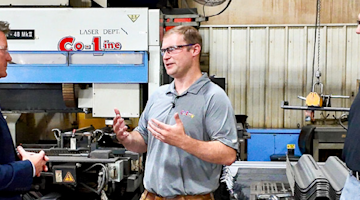When the notes fit together just right, you are making music. When the parts fit together just right, you are manufacturing music.
The new IMTS+ Original Series “Passion Project” kicks off with “The Harmony of Art & Technology.” This first episode explores how art and technology blended harmoniously in a collaboration between legendary music manufacturer C.F. Martin & Co. and two manufacturing giants, Mazak and Renishaw.
Together, the companies created an innovative approach that blends the craftsmanship of instrument-making with the precision of manufacturing. Their project highlights the harmony of art and technology, resulting in an improved guitar fabrication process. Martin Guitar, which has built instruments since 1833, used this new process in their 3 millionth serialized instrument.
The Players
When Lou Goffredo, the engineering services manager at Martin Guitar, went to IMTS – The International Manufacturing Technology Show, he was seeking a solution to a long-standing challenge: the manual freizing process. A time-consuming and labor-intensive endeavor, manual freizing involves cutting a channel around the perimeter of a guitar body to install decorative elements.
Martin Guitar is dedicated to constantly improving the quality of both their instruments and processes. With the full support of Executive Chairman Chris Martin, a sixth-generation leader of the company, Goffredo set out to explore automation solutions.
At IMTS, Goffredo met Bill Curtis, the applications engineering manager at Mazak, and Dan Skulan, the general manager of industrial metrology at Renishaw. They immediately connected. They were all proud to work for family-run or family-owned businesses and eager to work together.
The key goals of the project were to increase quality and reduce operator injuries.
“They wanted to reduce repetitive motion injuries and improve the safety of the process for the operator,” notes Curtis.
After spending months developing the ideal solution, Martin Guitar, Mazak, and Renishaw had a prototype and were ready for test cutting.
In addition to protecting workers, the process had to be precise to preserve both instrument quality and the valuable raw materials that go into custom guitars.
Skulan explains, “The challenge here was you have a very beautiful piece of art, and it is a one-off. We needed to measure it and do a cut on it, and every single one is different.”
With no room for error, the team developed a process that uses technology to ensure the bindings and trim fit every time.
The automated freizing process has now been deployed on the Martin factory floor for nearly two years and has proved itself. The proof is in the performance.
“It was a win-win for us when it comes to preserving our operators, making things better for our operators, and it produces better quality and actually improves the appearance of our instruments as well,” concludes Goffredo.
Along with collaboration comes strong partnership. All three managers are quick to point out that the success they achieved wouldn’t have been possible without the amazing work of the talented people on each of their teams.
Whether you are learning chord progressions or programming a machine, there are many parallel skills required for both music and manufacturing. In this partnership, the art of making outstanding instruments blended perfectly with the technological capabilities of modern manufacturing.
Don’t miss this inspiring fusion of art and technology in the first episode of the new IMTS+ Original Series “Passion Project.” Watch “The Harmony of Art & Technology” now to see how C.F. Martin & Co., Mazak, and Renishaw enhanced guitar-making at IMTS.com/Passion/Project/HART.
To read the rest of the Emerging Markets Issue of MT Magazine, click here.






